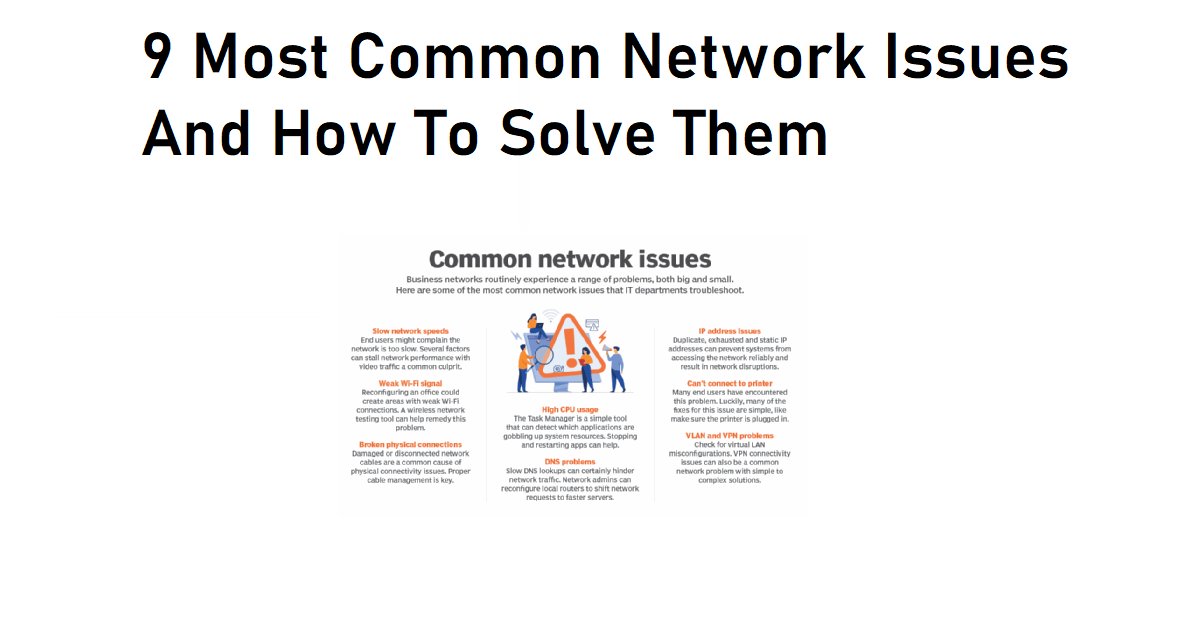
In the dynamic realm of Signs That A Current Network Technology Has Outlived Its Usefulness?, the expiration date of network systems often remains hidden until it's too late. However, one glaring sign that a network technology has outlived its usefulness is the inability to keep pace with advancing demands. When your once cutting-edge system struggles to accommodate new software updates, experiences frequent downtime, or simply cannot handle increased data traffic, it's a telltale signal that it's time for an upgrade.
Obsolete network technology also tends to lag in providing adequate speed and efficiency, hindering productivity and causing frustration among users. When routine tasks take longer than they should or there's a noticeable delay in accessing data or applications, it's a strong hint that your network technology has fallen behind the curve. To thrive in today's hyper-connected landscape and maintain a competitive edge, recognizing these signs and investing in newer.
Top 5 Signs That A Current Network Technology Has Outlived Its Usefulness?
Network infrastructure, like any technology, isn't immune to the march of progress. Just as your trusty flip phone wouldn't cut it in today's smartphone world, clinging to outdated network techcan hold you back. So, how do you know when it's time to say goodbye and hello to the new and improved? Here are the top 5 signs that your current network has outlived its usefulness:
1. Snail-Pace Speeds
Feeling the constant frustration of dial-up-esque latency and painfully slow downloads? This is a prime indicator that your network can't keep up with your needs. Modern applications and cloud-based services demand high bandwidth, and clinging to outdated tech leaves you lagging behind.
2. Security Nightmares
Is your network riddled with vulnerabilities, patched together with duct tape and hope? Outdated protocols and unpatched systems attract cyber threats like moths to a flame. Upgrading to robust, secure technologies safeguards your valuable data and keeps your operations safe.
3. Scalability Woes
Does your network buckle under the strain of even moderate traffic spikes? Businesses grow, and your network should grow with them. If adding users or devices triggers bottlenecks and outages, it's time for a more scalable solution.
4. Management Madness
Does managing your network involve arcane rituals and blood sacrifices (figuratively, of course)? Complex, clunky interfaces and a lack of automation slow you down and increase the risk of human error. Modern networks offer simple, intuitive management tools that streamline operations and free up your time.
5. Compatibility Conundrums
Is your network living in a silo, refusing to play nice with newer devices and software? Incompatibility issues create headaches and hinder progress. Upgrading to open standards and interoperable technologies creates a seamless, unified network experience.
Bonus Sign -Feeling like your network is a dusty relic from a bygone era? Don't ignore that gut instinct! New technologies offer improved performance, efficiency, and cost-saving benefits. Investing in an upgrade isn't just about keeping up; it's about boosting your competitiveness and setting your businesson the path to future success.
Network upgrades aren't just about the latest gadgets. It's about building a foundation for growth, innovation, and enhanced security. So, listen to the signs, and don't hesitate to embrace the exciting world of next-generation network solutions!
What You Need To Know About Predictive Network Technology
Imagine a network that can anticipate problems before they occur, automatically adjust to changing demands, and optimize performance like a self-driving car. That's the promise of predictive network technology,and it's revolutionizing the way we manage and experience networks.
What Is It?
Predictive network technology utilizes artificial intelligence (AI) and machine learning (ML) to analyze vast amounts of network data. This data includes everything from traffic patterns and device information to resource usage and historical trends. By identifying patterns and relationships within this data, the technology can predict future network behavior and potential issues.
Benefits Of Predictive Networks
1. Proactive Problem Prevention -Instead of scrambling to fix outages after they happen, predictive networks can identify potential problems early and take corrective action before they impact users. This translates to reduced downtime, improved performance, and a better overall network experience.
2. Enhanced Security -Predictive analytics can detect anomalous network activity that might indicate malicious intent. This allows for faster and more effective threat detection and mitigation, keeping your network and data safe.
3. Optimized Resource Allocation -By understanding traffic patterns and resource usage, predictive networks can dynamically allocate resources to ensure efficient operation and prevent bottlenecks. This translates to cost savings and improved businessagility.
4. Automated Network Management -Many predictive network solutions offer automation capabilities that can handle routine tasks like configuration changes and performance tuning. This frees up IT staff to focus on strategic initiatives and innovation.
How Does It Work?
There are three key components to predictive network technology:
- Data Collection -Sensors and monitoring tools gather data from various network devices and applications.
- Data Analysis -AI and ML algorithms analyze the collected data to identify patterns and trends.
- Prediction and Action -Based on the analysis, the technology predicts future network behavior and takes corrective action or provides recommendations to network administrators.
Examples Of Predictive Network Technology
- Predicting and preventing bandwidth bottlenecks -By analyzing traffic patterns, a predictive network can anticipate peak usage periods and automatically adjust bandwidth allocation to avoid congestion.
- Identifying and isolating security threats -AI-powered anomaly detection can pinpoint suspicious network activity and automatically isolate infected devices to prevent further harm.
- Optimizing cloud workloads -Predictive analytics can help optimize resource allocation for cloud-based applications, ensuring efficient performance and cost savings.
The Future Of Predictive Networks
As AI and ML continue to evolve, predictive network technology will become even more sophisticated and integrated into our everyday lives. We can expect to see:
- Self-healing networks -Networks that can automatically diagnose and fix problems without human intervention.
- Hyper-personalized network experiences -Networks that adapt to individual user needs and preferences in real-time.
- Predictive maintenance -Networks that predict equipment failures and schedule preventive maintenance to avoid downtime.
The Bottom Line:
Predictive network technology is not just a buzzword; it's a game-changer that is transforming the way we manage and experience networks. By embracing this technology, businesses can ensure a more reliable, secure, and efficient network that supports their growth and innovation initiatives.
9 Most Common Network Issues And How To Solve Them
A healthy network is the backbone of our digital lives, keeping us connected to the internet, our devices, and each other. But just like any complex system, networks can experience hiccups and glitches. Here are the 9 most common network issues you might encounter, along with some quick fixes to get you back online:
1. Slow Internet Speed
- Symptoms -Videos buffering, slow downloads, sluggish web browsing.
- Possible causes -Outdated router, inadequate internet plan, interference from other devices, clogged cache.
- Fixes -Restart your router and modem, upgrade your internet plan, move your router to a central location, clear your browser cache and cookies, disable bandwidth-hogging applications.
2. Weak Wi-Fi Signal
- Symptoms -Difficulty connecting to Wi-Fi, frequent dropouts, slow speeds in certain areas.
- Possible causes -Physical obstacles, router location, interference from other wireless devices, outdated router firmware.
- Fixes -Move your router to a central location away from obstacles, update your router's firmware, disable unused wireless channels, consider a Wi-Fi extender or mesh network.
3. Connection Drops
- Symptoms -Frequent disconnects from the internet or network, inability to access certain websites or services.
- Possible causes -Faulty cables, overloaded network, internet service provider (ISP) issues, outdated drivers.
- Fixes -Check your cables for damage and replace if necessary, reduce the number of connected devices, contact your ISP if the problem persists, update your network adapter drivers.
4. DNS Errors
- Symptoms -Inability to access websites, error messages like "DNS server not found" or "This site can't be reached."
- Possible causes -Incorrect DNS settings, overloaded DNS server, ISP issues.
- Fixes -Change your DNS server to a public option like Google Public DNS (8.8.8.8) or Cloudflare (1.1.1.1), restart your router and modem, contact your ISP if the problem persists.
5. Printer Connection Issues
- Symptoms -Inability to connect to the printer wirelessly or via USB, printing errors, printer offline.
- Possible causes -Incorrect printer settings, outdated drivers, firewall interference, network congestion.
- Fixes -Ensure your printer is turned on and connected to the network, reinstall your printer drivers, temporarily disable your firewall, reduce the number of printing jobs in the queue.
6. File Sharing Problems
- Symptoms -Inability to access shared files on other devices, slow transfer speeds, permission errors.
- Possible causes -Incorrect network settings, disabled file sharing services, antivirus interference, firewall blocking.
- Fixes -Verify your network settings and file sharing permissions, enable file sharing services on all devices, temporarily disable antivirus software, adjust firewall settings to allow file sharing.
7. Network Security Breaches
- Symptoms -Unusual device activity, unauthorized access attempts, malware infections, slowdowns, data breaches.
- Possible causes -Weak passwords, outdated software, phishing attacks, insecure connections.
- Fixes -Change your network passwords regularly, update your devices and software with the latest security patches, be cautious about clicking on suspicious links or opening attachments, use a strong firewall and antivirus software.
8. Device Compatibility Issues
- Symptoms -Inability to connect certain devices to the network, error messages about incompatible protocols or drivers.
- Possible causes -Outdated firmware on devices, incompatible network configurations, driver conflicts.
- Fixes -Update the firmware on your devices, verify your network settings are compatible with the devices, check for driver conflicts and update or reinstall drivers if necessary.
9. Limited Bandwidth
- Symptoms -Slowdowns during peak usage times, difficulty streaming video or gamingonline, data usage exceeding limits.
- Possible causes -High number of connected devices, bandwidth-hogging applications, outdated internet plan.
- Fixes -Monitor your bandwidth usage and identify peak times, limit the number of connected devices, close unnecessary applications, consider upgrading your internet plan if needed.
Network Troubleshooting Scenarios For Intermittent Network Problems
Intermittent network problems can be frustrating and difficult to diagnose. Here are some troubleshooting scenarios to help you identify and resolve these issues:
Scenario 1 - Sporadic Disconnects
- Symptoms -Your connection drops frequently, making it difficult to stay online. This can happen on all devices or just specific ones.
- Possible causes -Faulty cables, Wi-Fi interference, overloaded network, unstable internet service, DHCP issues.
Scenario 2 - Slow Speeds At Certain Times
- Symptoms -Your internet speed slows down significantly during specific times of day or when certain applications are used.
- Possible causes -Bandwidth throttling by your ISP, high network traffic during peak hours, outdated router firmware, application limitations.
Scenario 3 - Random Website Access Issues
- Symptoms -You can't access certain websites or receive error messages like "DNS not found" or "This site can't be reached," but other websites work fine.
- Possible causes -DNS server issues, website outages, browser cache issues, firewall or antivirus interference.
Scenario 4 - Device-Specific Connection Problems
- Symptoms -Only one device or a specific group of devices can't connect to the network while others work fine.
- Possible causes -Incorrect device settings, incompatible network protocols, outdated drivers, hardware issues.
These are just a few scenarios, and the specific troubleshooting steps will vary depending on your network setup and the nature of the problem. If you're still struggling after trying these tips, consider contacting your ISP or a network technician for further assistance.
What Are Some Of The Key Technologies That Make Computer Networks Possible?
Computer networks rely on a fascinating symphony of technologies working together seamlessly. Here are some of the key components that make them possible:
1. Hardware
- Network devices - These include routers, switches, modems, and firewalls, all responsible for directing data traffic across the network. Routers guide packets (data units) to their destination, while switches connect devices within a specific network segment. Modems translate signals between digital and analog formats for communication over phone lines or cable. Firewalls filter incoming and outgoing traffic to protect the network from unauthorized access.
- Transmission media -This refers to the physical paths through which data travels, like cables (fiber optic or copper), wireless signals (Wi-Fi, Bluetooth), or even satellites. The choice of media depends on factors like distance, bandwidth requirements, and security considerations.
- End devices -These are the computers, smartphones, tablets, and other devices that connect to the network and utilize its resources.
2. Software
- Network operating systems (NOS) -These manage network resources, control access, and facilitate communication between devices. Popular NOS include Windows Server, Linux (various distributions), and macOS Server.
- Internet Protocol (IP) -This fundamental protocol defines how data is addressed and routed across the internet. Each device connected to the internet has a unique IP address that serves as its online identity.
- Transmission Control Protocol (TCP) -This protocol ensures reliable data transmission by breaking down information into packets, sequencing them, and checking for errors at the receiving end. It’s like a postman who carefully packages, sends, and confirms delivery of a letter.
- User Datagram Protocol (UDP) - This simpler protocol prioritizes speed over reliability. It sends data packets without error checking, making it suitable for applications like streaming media where occasional packet loss might not significantly impact the experience.
- Network security protocols -These protocols, like encryption and authentication, protect networks from unauthorized access, data breaches, and cyberattacks.
3. Communication Protocols
These define the rules and format for data exchange between network devices and applications. Examples include Ethernet for wired networks, Wi-Fi for wireless networks, and Bluetooth for short-range connections.
FAQ's About What's A Key Sign That A Current Network Technology Has Outlived Its Usefulness?
What Are The Uses Of Network Technology?
The primary uses of computer networks are to facilitate communication, enable resource sharing, provide remote access, and collaborate. Computer networks are essential for businesses, educational institutions, and individuals who rely on technology to connect with others and access resources.
What Is The Technology Of Network Based System?
Network technology includes routers, switches, cables, wireless access points, and hubs. It also includes protocols such as Ethernet and TCP/IP that are used to set up connections between different types of devices on the network. It can be used for many different purposes including : File transfer.
What Is The Summary Of Network Technology?
Network Technology involves the use of data systems to manage and deliver digital resources over a computer network. A variety of industries use computer hardware and system software that maintains a network, creating a need for specialists to manage them.
Conclusion
Recognizing the signs that indicate your current network technology has reached its expiration point is crucial for staying ahead in the ever-evolving tech landscape. When faced with persistent connectivity issues, security vulnerabilities, sluggish performance, or an inability to adapt to modern demands, it becomes evident that your network technology is no longer efficient or effective.
By acknowledging and acting upon these indicators of obsolescence, you pave the way for a more efficient, secure, and resilient network infrastructure. Upgrading to newer technologies equipped with innovative features not only resolves existing issues but also prepares your network to navigate the complexities of tomorrow's digital landscape. Stay proactive, stay adaptable, and leverage the power of modern networking solutions to keep your business or personal endeavors at the forefront of technological progress.
See Also: How To Increase Internet Speed And Quality - 12 Ways To Speedup

